|
|
Post by Icctrombone on Aug 22, 2019 6:18:38 GMT -5
I'd give the first Iron Man story in Tales of Suspense a straight A. As a reviewer I am laser-focused on the craft of storytelling, and here the craft is impeccable. My persepctive: (A) This is an early silver age Marvel comic, so it's not exactly a superhero comic. Like Fantastic Four # 1 or the Lava Man story in Journey into Mystery # 83, the focus is on darker emotions. Oh, and monsters. Yep, Iron Man is the monster. I bet that 99% of current readers would miss that, but 99% of the intended audience in 1963 would intuitively understand this. "Listen to his ponderous footsteps as he lumbers closer....closer!" You're rooting for the monster, but the tone of the story is dark suspense - damn close to horror - and this story feels more like Frankenstein than Superman. (B) Don Heck is an extremely good suspense artist. He never quite adapted to Kirby style bombast but when he's doing more subtle stuff (like here!) he can be just masterful. The bottom of page 4, especially...  Let's walk through this real quick. Panel 1: Conveys explosive action but the camera is still way far away, so the fighting is a little muted, distant. Also note how well Heck defines the setting where the story is happening. Panel 2/3: Amazing. AMAZING. Post-Silver Age there are approximately 0 artists efficient enough to pull this off. A quiet, subtle, moody jungle scene is slash paneled with an extreme close up as the camera STABS in and image is magnified by a thousand in the bottom half. All of a sudden we are no longer distant observers, but we are so close we are seeing things that even the Tony Stark is missing! The literary term for this is... I forget... googles... Dramatic Irony, where the audience knows something the characters don't. How often do you see THAT kinda high-falutin' storytelling in comic books? Panel 3: The camera angle changes again, and we are no longer separated from the scene. Now the camera positions us just very, very slightly above the action (with all the main figures in the panel tilted slightly to indicate surprise and chaos) and BARROOM! The dramatic promise of the last two quiet, subtle panels pays off! Panel 5: Stark looks small and a looming figure is foreshadowing on top of him! We see the briefest hint of a gun aimed at Stark's head. Very subtle, very chilling. Panel 6: Look at the body language here. The "Guerilla Chief" gives a sense of unhurried, masterful arrogance. Heck is really good at imbuing his figures with this kind of muted, calm emotion. (C) This is an extremely suspenseful tale! Moving on, I'm impressed by how the dialog keeps the storytelling pressure up. " Every tick of the clock brings the deadly piece of shrapnel closer to my heart!" (D)  Again, very subtle, very chilling. Note how often, and effectively, the "dramatic set-up/payoff" structure is applied. The main focus of panel 3 is the moon! Heck is doing a hell of a job using setting and atmosphere with only quick glances of Iron Man to tell the story. Also, note the the Point of View character switches from Wong-Chu to Iron Man. There's no huge MEANWHILE but see how effectively our main character changes. (E) Again, I think the last few pages are amazing. The narrative POV character changes back to Iron Man and then Wong-Chu again, and the story is now PURE horror, as our hapless Communist villain is stalked by an unrelenting Iron.. thing! You can feel his mounting terror and you have to sympathize with him a little bit because you see the "world" through his eyes and you know he.. is... in... trouble.  Except that panel, which is pretty funny. Nice break in the tension. This story completely works for me, although it's very different from what Iron Man would turn into. Although, honestly, I've never been a huge Iron Man fan. And "Man Trapped in the Body of Iron Monster" might be a more interesting hook than what we got. Anyway, Iron Man is not the best Silver Age origin story, but I'd put it at # 3 among major characters. Best Silver Age Origin Stories: 1) Sgt. Rock (errr. the first one) 2) Spider-Man 3) Iron Man 4) Dr. Strange 5) Hawkman (I'd rate Enemy Ace and Secret Six higher, but I can't count them as major.) Awesome analysis of the storytelling, Rep. I always considered Don Heck " MY" Avengers artist. I loved the layouts and facial expressions that he created in those first 40 or so issues. I read many members say his superhero stuff wasn't as good as his other work, I disagree. |
|
|
|
Post by codystarbuck on Aug 22, 2019 11:38:51 GMT -5
I like Heck's Avengers stuff and what I have seen of his Iron Man. I think he gets a bad rep, based on the way his art progressed, in this environment, in the 70s. Vision problems and some other health issues took their toll, by the time he was working for DC; but, his stuff in the 60s is great. I think he is the victim of too many people who wanted everything to be Kirby or Ditko. Jack had a deep respect for Heck and asked him to ink his New Gods concept pieces, which speaks volumes. The problem is that Heck was more comfortable working from script than plot, as he wasn't as spontaneous as Kirby or Ditko.
Heck's women, though, are some of the best of the era, looking like real women, while still being exciting characters, as well as glamorous and beautiful. He handled average people far better than most of the generation who followed and pushed him to the side.
|
|
|
|
Post by beccabear67 on Aug 22, 2019 12:41:55 GMT -5
Yep, Iron Man is the monster. Yes! The early '60s Marvels do have monsters on the brain. Some of the characters like The Thing, the villain Sandman, and Ant-Man first appear in the horror-monster comics, also a prototype Doctor Strange. Thor was often battling large creatures and giants. The Hulk, Moleman, Spider-Man all have monster comic aspects, and the Fantastic Four didn't get uniforms right away. |
|
|
|
Post by captainthor on Aug 23, 2019 9:04:12 GMT -5
beccabear67: Thank you for following the thread! I hope to keep producing reviews which people enjoy talking about, I've been very happy with the response so far. Reptisaurus!: Interesting analysis, it's nice to see a detailed and passionate analysis of Tony's origin story. However, I disagree with you on a few points. I agree with you that Tales of Suspense 39 is influenced by tales such as Frankenstein and the horror/monster genre. I also agree that, in some ways, Iron Man could be viewed as the monster in the story. However, I disagree with you that the story is more Frankenstein than Superman simply because, for me, the horror elements of the story don't resonate while the superhero aspects of the story resonate more successfully. I think the story very much follows the structure of a classic superhero origin story. You establish the basic character traits of the hero (which is the most successful part of the story and the writing in my view), the hero has a life-changing experience and the hero normally fights and defeats his first villain to prove his heroism. This story definitely corresponds to that basic structure. For Tony Stark in Vietnam see Bruce Wayne's parents dying or a radioactive spider-bite or the Fantastic Four going into space and being blasted by cosmic rays. That basic structure is fundamental to the story. More importantly, to me, the horror elements of the story fall flat for two reasons. Firstly, within about 5 pages of Tales of Suspense 40, Iron Man's horrifying appearance is acknowledged, dealt with and never mentioned again. Naturally this undercuts the horror that is present in Tales of Suspense 39. Secondly, for me, the climax doesn't work as well as it does for you. I do not feel horrified about Wong-Chu's fate. The reason for this is simple. Wong-Chu is a completely cartoonish character. In order for me to feel the horror elements in this story, I would have needed Iron Man to be chasing a character who I can sympathise with or at least relate to on a human level. I cannot relate to Wong-Chu as a character so his fate does not come across as horrifying to me. For me, a successful horror story, in fact any successful story relies on characters that I can relate to on an emotional level. That doesn't mean that I have to like those characters but I have to be able to relate to them. For example, in The Sopranos TV series, I don't like Tony Soprano but I can relate to him so the story resonates. I can't emotionally connect to Wong-Chu so the horror elements of the story don't resonate. codystarbuck: Although he was not on the level of Kirby or Ditko, Don Heck is a perfectly competent artist. He, unfortunately, often gets compared to two truly great artists which means his work is a little bit underappreciated.
|
|
|
|
Post by captainthor on Aug 23, 2019 10:36:25 GMT -5
Tales of Suspense 41- The Stronghold of Dr Strange Plot: Stan Lee Scripting: Robert Bernstein Art: Jack Kirby Inking: Dick Ayers Lettering: Marty Epp Grade: D+Cover: 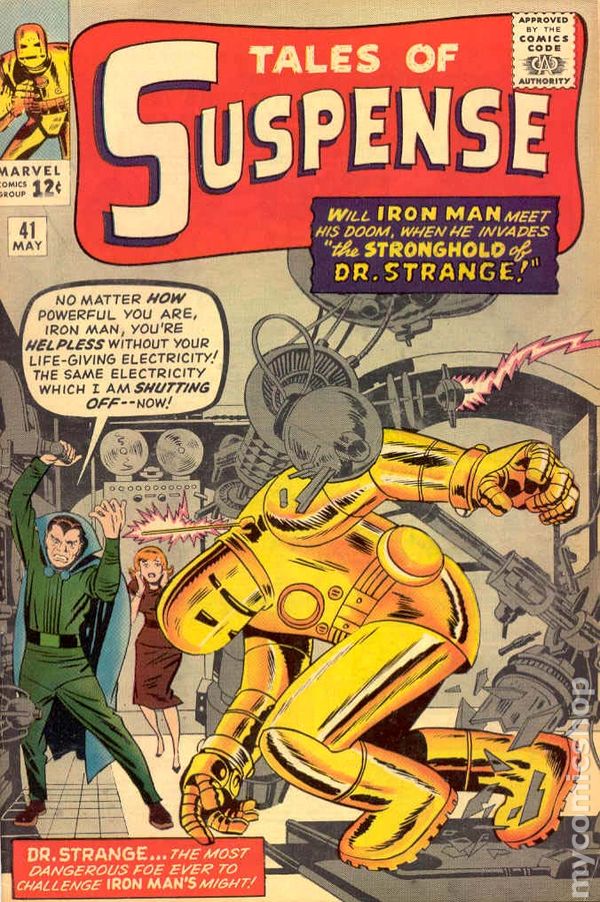 Synopsis: The issue starts with Tony Stark at a charity gala for the opening of a new hospital. Tony is giving money to the hospital and is arranging an Iron Man appearance for the previous day. This segment also focuses on a conversation between Tony and his unnamed date to the gala. Tony focuses on his daily responsibilities in this segment, discussing his roles as a scientist, a munitions designer and his role providing assistance and demonstrations to the US military. Tony then thinks about the added responsibilities which are created by his new role as Iron Man:  Iron Man then goes to the hospital to entertain the children where his armour is hijacked by the insidious Dr Strange (that is Dr Carlo Strange not Dr Stephen Strange). Dr Strange uses the armour to escape from prison. He then retreats to his private island where he invites some of the world's most evil geniuses and military men along with his own daughter, whose love he is trying to win by allowing her to benefit from the fruits of his super-villainy. He uses some nuclear weapons to hold the world to ransom but Iron Man infiltrates Dr Strange's base and defeats him after Dr. Strange's daughter betrays him. Analysis: This issue is, in many ways, fairly similar to Tales of Suspense 40. It follows the same structure. Most of the first-half of the story is devoted to character work focusing on Tony Stark and the second-half of the story is devoted to a standard single-issue Silver Age plot. The characterisation of Tony Stark remains pretty good in the first-half of the story. I've discussed in my previous two reviews about my frustration with Stan Lee's failure to really explore the consequences of Tony Stark becoming a hero while remaining a munitions designer during the Cold War as the Vietnam War is just beginning so I want to devote a bit more time here to analyse on what Stan Lee actually does focus on. The issue goes into more detail about the difficulty which Tony Stark has in balancing his various responsibilities with his playboy lifestyle. Even though it is not the character arc I want to see, it is still fairly interesting in its own right. The main thing which allows this arc to work is that the reader gets the impression that Tony Stark enjoys being a playboy. It's clearly an important part of his life and he clearly misses it when he is unable to fully enjoy it due to his health issues combined with his roles and responsibilities as head of Stark Industries and as Iron Man. It makes Tony's actions as Iron Man somewhat heroic as the reader feels that he is sacrificing a part of his life which he enjoys in order to do something noble. The main issue with this arc occurs when you compare it to other Marvel productions from the same era. A major feature of Marvel's method of storytelling in the 1960s was the creation of heroes who have human flaws and failures along with human roles and responsibilities to juggle. Iron Man losing his playboy lifestyle works in that it does allow the reader to sympathise with him on some level and to feel that Iron Man is a human. A human who is, on the surface, very successful and "the guy who has it all". But a human nonetheless. But, it's harder to sympathise with Tony Stark not being able to be a playboy than it is to sympathise with the various sacrifices which Spider-Man has to make in order to be a superhero. As a reader, although I appreciate that Stark is sacrificing something to become Iron Man, I can't help but think that it's not as big a sacrifice as most people would have to make in order to become Iron Man. We all have issues in our life. I can't help but think that Tony Stark's inability to be a playboy isn't the greatest loss in the world even though I can appreciate that, from his perspective, he is sacrificing a big part of his life in order to be Iron Man. Another good aspect of the characterisation of Stark here is that it clearly illustrates how many responsibilities Stark has in his life. Being head of a large corporation is, despite its many rewards, quite stressful and quite time-consuming. He has to design weapons and gadgets in order to make money for Stark Industries. He has to manage the business side of the operation. He has to deal with demonstrations for potential buyers and he has to manage the PR side of the company. He may even, at times, need to inspect the installation and field use of the various pieces of technology designed by Stark Industries. Moreover, look at the page I included in my plot synopsis showing the various responsibilities he has as Iron Man. Tony Stark has a lot on his plate and the issue does a good job of showing this to the reader. The final character aspect that I appreciated here was that the issue illustrates that, at heart, Tony Stark is a noble soul. He's a noble soul who is heavily shaped by his life experiences as a successful industrialist who has always belonged to the wealthiest strata of American society. But, nevertheless, he is a noble soul. The reader gets the impression that he cares about donating his time and money to the hospital and its patients. This is an important character beat for Tony that is successfully established here. The donation to the hospital also highlights the fact that Tony Stark can often do as much or more to help the world than Iron Man can. This idea is explored more fully in the 00s when Tony becomes Secretary of Defense and then Director of SHIELD but it's nice to see it established here. Now onto the major issue with the story which, as with the previous two issues, is largely to do with the Silver Age plot. To be fair, at least conceptually, Carlo Strange works better as a villain than either Gargantus or Wong-Chu did. He's a classic megalomaniac. He's a super-genius. He's evil. It's a type of villain which can work well in a Silver Age story and, with further development, can be turned into a genuinely interesting villain like Dr. Doom. It's simplistic but at least it's a better concept than giant caveman alien robot. Moreover, there's even an attempt to introduce some pathos into the character by creating a relationship between him and his daughter, Carla. This is an attempt at more nuanced characterisation of a villain. If executed well, showing a villain's familial relations is a great way to introduce pathos to a character. The first issue here is in the execution. Look at the following panel: 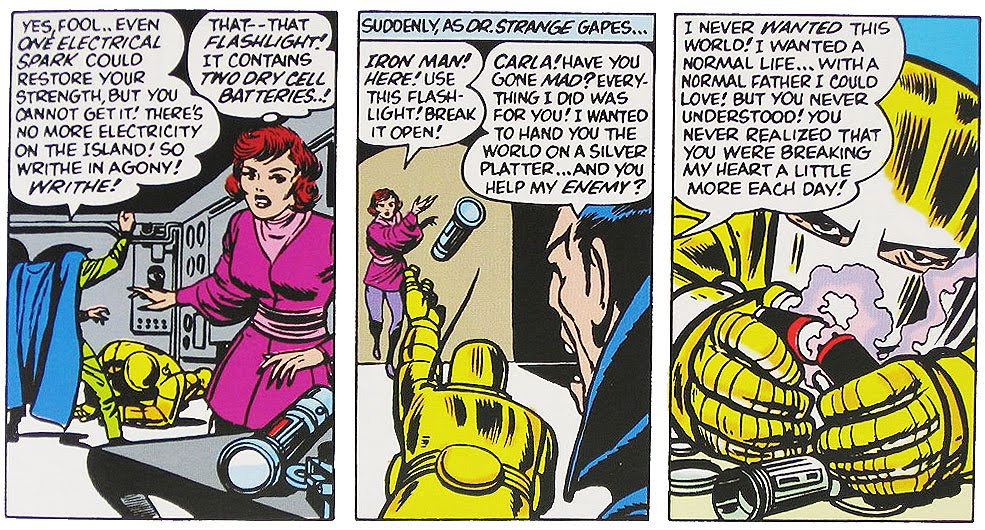 It's a basic fundamental of good storytelling that a writer should show rather than tell. The characterisation of Tony at the start of the story works, in part, because it shows us the responsibilities and pressures which Tony has to deal with along with telling us about them. Too often, Dr. Strange's character traits and the dynamic between Carlo and Carla are simply listed on the page. Look at the final panel of the above screenshot. Why does Carla need to state that she would rather have a normal father compared to a megalomaniac? It feels like Strange's characterisation is often directly copied from the description of the character and is then passed off as dialogue. The second major issue concerns the characterisation of Carla. Now, this story was written in 1963. As a reviewer I have to be aware that social attitudes were different in the 1960s. I then have to decide whether to give leeway to the story or not when reviewing it. Carla is a stereotype. There is no depth to her characterisation. It's troubling to a modern reviewer. Moreover, there are certain basics of storytelling which need to be applied even to a Silver Age story. There are Silver Age stories which manage to depict interesting, three-dimensional female characters. This story... fails to do that. This naturally ruins the attempt to add pathos to the character of Carlo Strange. And it's the main reason why this story was a D+ rather than a C-. |
|
|
|
Post by beccabear67 on Aug 23, 2019 13:49:36 GMT -5
^ I dunno... I can relate a bit to "I wanted a normal life... with a normal father..."  Tony Stark is becoming more of a sympathetic character despite that trope of the playboy thing that served as a cover for Bruce Wayne so long. I related more to his being a businessman and inventor, plus the heart problem... they really didn't need the trappings of playboy millionaire I didn't think (and could've been clearer that the Rolls Royce level wealth was based on his profitable work). A lot of comic writers seemed to feel readers wanted that fantasy dream life of astronauts, millionaires and movie stars with mansions and elaborate (and expensive) headquarters... as you allude, Peter Parker broke that mold. I used to wonder if Reed Richards, Henry Pym and Tony Stark would ever have a competition for this title of most brilliant inventor (and Peter Parker was no slouch with those mask eye coverings, web fluid and web-shooter). "Uh oh Iron Man, you should've bought Duracel, it keeps going and going..." |
|
|
|
Post by Deleted on Aug 23, 2019 18:31:31 GMT -5
captainthor ... I'm enjoying this thread very much and keep up the good work here.
|
|
|
|
Post by Reptisaurus! on Aug 24, 2019 1:42:26 GMT -5
beccabear67 : Thank you for following the thread! I hope to keep producing reviews which people enjoy talking about, I've been very happy with the response so far. Reptisaurus! : Interesting analysis, it's nice to see a detailed and passionate analysis of Tony's origin story. However, I disagree with you on a few points. I agree with you that Tales of Suspense 39 is influenced by tales such as Frankenstein and the horror/monster genre. I also agree that, in some ways, Iron Man could be viewed as the monster in the story. However, I disagree with you that the story is more Frankenstein than Superman simply because, for me, the horror elements of the story don't resonate while the superhero aspects of the story resonate more successfully. I think the story very much follows the structure of a classic superhero origin story. You establish the basic character traits of the hero (which is the most successful part of the story and the writing in my view), the hero has a life-changing experience and the hero normally fights and defeats his first villain to prove his heroism. This story definitely corresponds to that basic structure. For Tony Stark in Vietnam see Bruce Wayne's parents dying or a radioactive spider-bite or the Fantastic Four going into space and being blasted by cosmic rays. That basic structure is fundamental to the story. More importantly, to me, the horror elements of the story fall flat for two reasons. Firstly, within about 5 pages of Tales of Suspense 40, Iron Man's horrifying appearance is acknowledged, dealt with and never mentioned again. Naturally this undercuts the horror that is present in Tales of Suspense 39. Yeah, that's true. There are definitely superhero elements in the story as well. One of the reason I like the early Marvel books is that there's a lot of different genres all jammed together. (The early Fantastic Four are Superhero + Space Adventure + Godzilla/Atomic Monster style horror + teenage Archie style hyjinks + romance.) Still, it's not that surprising that the first would follow up 38 issues of (moody, post-code) horror (ish) stories in Tales of Suspense with a horror story in # 39. And, honestly, I think good criticism can look at a story at the time it was written, and consider the audience it was aimed for, and judge that story on it's own merits. The comics that followed do not change the content of Tales of Suspense # 39. I don't see any critical advantage in ignoring historical context. I'm actually really curious about your reasoning, since "Ignoring historical context" seems to be one of the major themes of your review style. That's kind of how horror works, though. "Evil guy does wrong, is punished by supernatural forces" (And I might be stretching the definition of supernatural here, but Stan obviously thought that transistors were magic...) Is an incredibly common horror trope. If you need to feel deep seated empathy for the victim, that's gonna make 80% of horror movies, books, and comics a tough slog. (Including the entirety of EC's horror output.) |
|
|
|
Post by captainthor on Aug 24, 2019 7:44:20 GMT -5
^ I dunno... I can relate a bit to "I wanted a normal life... with a normal father..."  Tony Stark is becoming more of a sympathetic character despite that trope of the playboy thing that served as a cover for Bruce Wayne so long. I related more to his being a businessman and inventor, plus the heart problem... they really didn't need the trappings of playboy millionaire I didn't think (and could've been clearer that the Rolls Royce level wealth was based on his profitable work). A lot of comic writers seemed to feel readers wanted that fantasy dream life of astronauts, millionaires and movie stars with mansions and elaborate (and expensive) headquarters... as you allude, Peter Parker broke that mold. I used to wonder if Reed Richards, Henry Pym and Tony Stark would ever have a competition for this title of most brilliant inventor (and Peter Parker was no slouch with those mask eye coverings, web fluid and web-shooter). "Uh oh Iron Man, you should've bought Duracel, it keeps going and going..." I don't actually mind Tony Stark fulfilling the playboy trope. I think the fact that Tony Stark actually enjoys the playboy scene whereas Bruce Wayne really does seem to view it as cover for his role as Batman. It's different enough from the main example of the playboy trope that I don't mind seeing it too much. It's a slightly different dynamic for a superhero and I think, as opposed to most of the major superheroes, Tony Stark is possibly more interesting than Iron Man. |
|
|
|
Post by captainthor on Aug 24, 2019 8:17:03 GMT -5
Yeah, that's true. There are definitely superhero elements in the story as well. One of the reason I like the early Marvel books is that there's a lot of different genres all jammed together. (The early Fantastic Four are Superhero + Space Adventure + Godzilla/Atomic Monster style horror + teenage Archie style hyjinks + romance.) Still, it's not that surprising that the first would follow up 38 issues of (moody, post-code) horror (ish) stories in Tales of Suspense with a horror story in # 39. And, honestly, I think good criticism can look at a story at the time it was written, and consider the audience it was aimed for, and judge that story on it's own merits. The comics that followed do not change the content of Tales of Suspense # 39. I don't see any critical advantage in ignoring historical context. I'm actually really curious about your reasoning, since "Ignoring historical context" seems to be one of the major themes of your review style. If the shift away from the idea of Iron Man as a monster had happened over a slow period of time it wouldn't be as big an issue for me. I do try not to be too influenced by subsequent stories. For example, when it comes to the idea that Tony Stark finds it difficult to juggle his new role as Iron Man with his role as a playboy millionaire industrialist, I'm looking at it on its own terms even though I'm aware that that character arc eventually becomes very played out during Stan Lee's run on the book. In this case though the shift happens in, like, 5 pages of the next book. It's kind of difficult for that not to affect my view on those genre elements on ToS 39 as it's such a sudden shift in the direct sequel. I'm aware of the tropes of the Silver Age. I'm aware that villains in the Silver Age are often somewhat cartoonish. I'm aware that social attitudes in the 60s were very different. But, for me, the two main fundamentals of good storytelling are an entertaining plot and effective characterisation. And those two criteria are kind of universal to good storytelling. For the record, ToS 39 actually DOES tick those two boxes for me, hence why it gets into the B range. I don't think that the following stories reach that level so I grade them lower. For ToS 39, I think I do discuss the historical context in my review. I just think I'm approaching the historical context from a different perspective. For me, the fact that there are horror elements in the story is nice but it doesn't really weigh on my review very much. My knowledge of the horror genre largely comes from studying Frankenstein. If I felt like the horror elements were executed more successfully I would give it more credit but I don't think they were. Personally, the historical context which interests me more is the Cold War context. That's why I focus on it in my initial review. And that's also not dealt with particularly well in ToS 39 for reasons I outline there. It's just personal preference at work there, different bits of context will naturally appeal to different reviewers. It's not about a character being good or evil. It's about a character being three-dimensional or two-dimensional. I used Tony Soprano as an example of a character (albeit not from the horror genre) who is evil but who I can understand as he is a three-dimensional character. Tony Soprano is a mob boss. He does all the evil things one would expect a mob boss to do. My issue with Wong-Chu isn't that he's a villain. It's that he's a villain who is very cartoonish and very two-dimensional. And again I get that that's common in the Silver Age. But it undercuts the horror elements of the story. And there are plenty of Silver Age stories with three-dimensional characterisation. It's a fundamental aspect of storytelling that ToS 39 gets right with Tony Stark but gets wrong with Wong-Chu. And sadly, Wong-Chu being two-dimensional means that the horror aspect of the story falls flat. I completely understand why the horror elements would land better for a different reader. But they don't for me and that's why. |
|
|
|
Post by captainthor on Aug 24, 2019 8:26:49 GMT -5
captainthor ... I'm enjoying this thread very much and keep up the good work here. Thanks MechaGodzilla, happy that people are enjoying the reviews. |
|
|
|
Post by profh0011 on Aug 24, 2019 13:51:11 GMT -5
There are a lot of reasons why I think I should refrain as much as possible from getting involved in this thread. However, I will pass on this bit of "fun". For a number of reasons, I've come to believe that the 3rd episode was actually written & illustrated FIRST. And then, due to editorial, the villains' identities were CHANGED before publication. Try thinking about the story if it had been THIS way instead and see what you think.  |
|
|
|
Post by profh0011 on Aug 24, 2019 13:53:20 GMT -5
Tony Stark 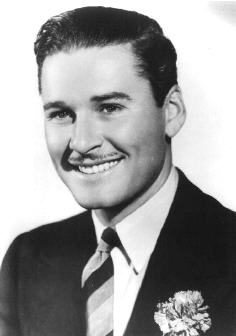 |
|
|
|
Post by codystarbuck on Aug 24, 2019 20:38:14 GMT -5
Tony Stark  To a point; but, here's old Howard... 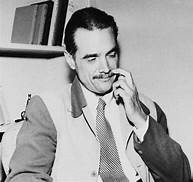 and Ronald Coleman... 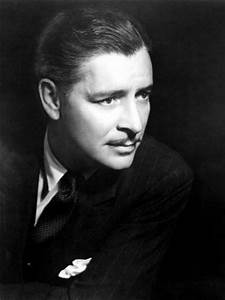 |
|
|
|
Post by captainthor on Aug 25, 2019 7:12:57 GMT -5
codystarbuck and profh0011 : Loving the 'tache pictures there. Tales of Suspense 42- Iron Man Trapped By The Red Barbarian Plot- Stan Lee Script- Robert Bernstein Inker- Don Heck Penciler- Don Heck Grade: C-Cover: 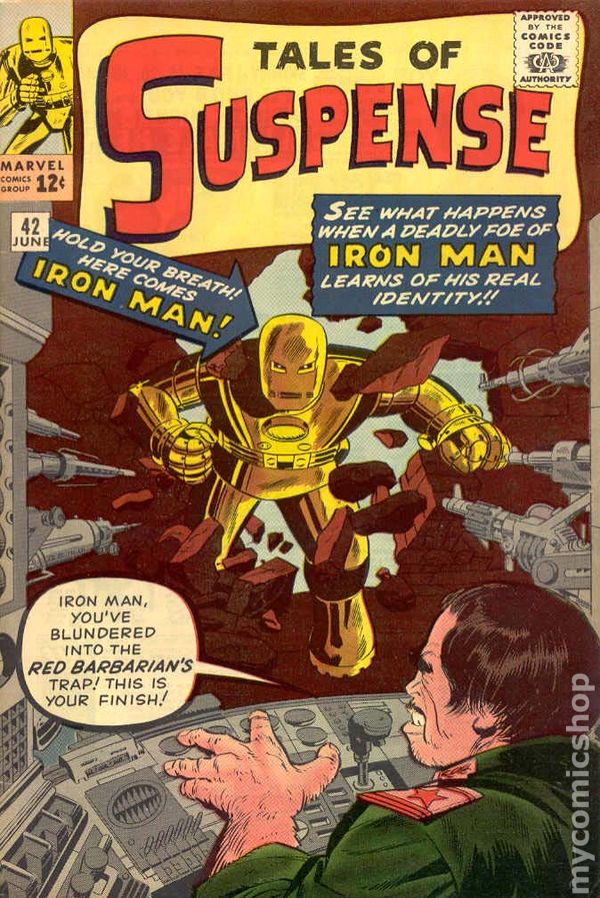 Synopsis: This issue starts with Iron Man breaking up a spy ring that has been organised by the Red Barbarian. Once the spies are handed over to the FBI, the issue progresses to the next day where Tony Stark is leading a weapons demonstration to some dignitaries from the US military. The weapon in question is a disintegrator ray which disintegrates solid objects. The Red Barbarian, a Soviet spy chief, hears of Stark's new weapon. He decides that he needs to steal it and spends time screaming at his flunkies to get the job done. His prayers are answered when The Actor, who can use make-up to mimic anyone's face appears and offers his services to the Red Barbarian, as seen in the panel below:  The Actor successfully infiltrates Stark's lab by pretending to be Tony Stark and steals the plans for the disintegrator ray. In the process he discovers that Tony Stark is Iron Man. The Actor returns to the Red Barbarian but is intercepted by Iron Man who locks him in his car and recovers the plans. Iron Man then approaches the Red Barbarian, pretending to be The Actor disguised as Iron Man, and states that he has the plans and will reveal them in a few hours. The Actor is then released from his prison by Iron Man and approaches the Barbarian to tell him the truth. The Barbarian believes that the Actor has betrayed him and has him shot. Analysis: This issue moves away from the structure which was used in the previous two stories. Instead of having a section devoted to characterisation and a section devoted to a Silver Age plot, the issue instead largely focuses on the Silver Age story of the Red Barbarian. The most interesting piece of characterisation here concerns the weapons demonstration given by Stark to the US military. This scene shows just how deep the connection is between Stark and the US military-industrial complex. Sadly, as discussed in my previous reviews, Stan Lee lacks the flair to really exploit the storytelling potential of this connection. Still, it's a nice character moment and it reinforces one of the themes of the Iron Man stories. I always have mixed feelings about these early Silver Age stories featuring Iron Man and Communist villains. On the one hand, I do think that an espionage story is a natural story for Iron Man to fit into. I often feel like Iron Man functions better in these stories than he does in a sci-fi story. For example, I enjoyed this story more than I enjoyed Iron Man's tussle with Gargantus a couple of issues ago. In particular, the section where the Actor infiltrates Stark's lab is pretty effective in my opinion. This is also influenced by the fact that the entire story is devoted to the Red Barbarian plot meaning that it feels a bit less rushed than earlier stories did, again I refer to Gargantus as an example. However, I also cannot feel like these stories represent a real missed opportunity. The Red Barbarian, like Wong-Chu in Tales of Suspense 39, is a cartoon villain. He is basically just "evil Communist". More nuanced villains would really have elevated these stories as the author may then have been able to seriously ask questions about Stark's role in the Cold War as a munitions designer. This could have resulted in some highly engaging and interesting stories. The villains of this story are a mixed bag. Largely, I liked The Actor and I disliked the Red Barbarian. The Actor was an effective lackey who posed a genuine threat to Tony Stark. He's a prototype-Chameleon and a shape-shifting villain in an espionage story is a natural combination which works well. The Red Barbarian is the story's main weak link. He's meant to be the guy who's pulling the strings behind the various Russian espionage operations in the US but he just doesn't seem very intelligent which significantly reduces his threat level and the resulting suspense in the story. Another thing which I didn't appreciate was The Actor finding out Iron Man's identity only to get killed off before he can reveal it. I never really liked Iron Man having a secret identity anyway. I always kind of felt like Tony Stark was always going to be a target for villainous activity so a secret identity was kind of pointless. And a story where a secret identity is almost revealed but then someone dies or gets amnesia or something is a superhero trope which was never interesting. The fact that Stark having a secret identity has never been interesting or seemed particularly necessary or useful in the first place and that aspect of the story falls even flatter than it normally would do.
|
|












